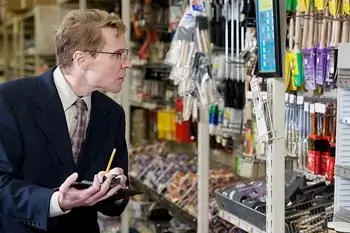2026 Author: Howard Calhoun | [email protected]. Last modified: 2025-06-01 07:12:56
When conducting an inventory at trading enterprises, shortages, surpluses, and regrading are often revealed. With the first two phenomena, everything is more or less clear: there is either a lot of this or that product, or a little. Re-sorting of goods is a rather unpleasant and difficult situation. Consider its features.

General information
The main reasons for the re-grading of goods are the negligence of financially responsible persons, the lack of proper control, violation of the rules for storing and receiving products at the warehouse. In some cases, it appears due to inattention during the release of products from the warehouse. Regrading of goods is a simultaneous surplus and shortage of products of the same name, but of different varieties.
Revision specifics
Inventory of goods is carried out in accordance with the Guidelines approved by Order of the Ministry of Finance No. 49 of 1995. Cases of mandatory audit are enshrined in Article 12 of the Federal Law No. 129. Inventory of goods is carried out without fail:
- Before the formation of annual accounts.
- When changing the financially responsible person.
- When facts of damage/theft of property or other abuses are discovered.
- After a natural disaster or other emergency.
- When liquidating/reorganizing an enterprise.
- In other cases established by law.
Documentation
The results of the audit are recorded in a special form of a unified form - a statement (f. INV-3). In this document, the lack of goods of one variety is indicated on one line, and the surplus on the other.

After filling out the form, it is transferred to the accounting department, where a collation sheet is formed (f. INV-19). In this document, columns 18-23 are intended to reflect regrading. Information is also indicated in the form INV-26.
In what cases is a regrading credit possible?
The conditions for offsetting are given in the Guidelines approved by Order of the Ministry of Finance No. 49. Offsetting is allowed if:
- surpluses and shortages identified in one audited period;
- one employee is responsible for the occurrence of sorting;
- shortages and surpluses were found in products of the same name and in equal quantities.
For example, if an excess of red toys is found in warehouse No. 3, and a shortage of green toys is found in warehouse No. 4, then this will not be a sorting of goods. Accordingly, offsetting is excluded. It cannot be carried out with a shortage and surplus of different products, and not the same, but of a different variety. These conditions must be met simultaneously. If one of them is not met, the surplus is accounted for separately, and the deficiency is written off from the balance.
Important moment
Often in practice there are difficulties with the definition of the name of products. This concept is not defined in the regulations. The Ministry of Finance recommends using the OKP product code. The All-Russian Classifier contains lists of products in which you can select the appropriate digital designation. Using the product code will avoid problems and significantly reduce the processing time of documentation.
Explanatory Guilty Employee
To identify all the circumstances of the incident, a commission is being formed. She is looking for the culprits. If a regrading is detected, a financially responsible employee (for example, a storekeeper) must provide an explanation.

It is addressed to the chairman of the commission. The financially responsible employee must indicate which goods were in excess and which were in short supply, in what quantity, and the reasons why this situation arose. The head of the enterprise has the right to apply a disciplinary sanction to a person.
Offer for offset
It is drawn up by the chairman of the commission in the name of the head of the organization. It is advisable to make an offset proposal if all the conditions listed above are met. Otherwise, the execution of this document will only be a waste of time. The proposal provides information about the inventory, during which the sorting was revealed, indicatenames, codes and quantity of products, the shortage and surplus of which were found. The document also reflects information from the explanatory note of the financially responsible employee. If necessary, information from the technologist's conclusion is additionally indicated, confirming the possibility of mutual replacement of products and the identity of product codes according to OKP.
Order
If the manager agrees with the proposal of the chairman of the commission, an order is issued to set off the sorting. It indicates information about the inventory carried out, the detected shortcomings and surpluses of goods, and briefly describes their reason. If there is a technologist's conclusion, the order also provides information from it. The order is sent to the chief accountant.
Comparison sheet
It records the results of the inventory, reflects the data on sorting. The collation statement is drawn up in 2 copies. The first is subject to transfer to a financially responsible employee, the second remains in the accounting department.

Information from the document is transferred to the statement by f. INV-26. It, in fact, determines the way to eliminate discrepancies: by set-off, write-off or attribution to the guilty party.
Date of regrading recognition
In practice, it is quite difficult, and in some cases even impossible, to determine the day on which the mistake was made that caused the discrepancies. It is only known for certain that this happened between inventories. According to experts, it is more expedient to indicate not the date of occurrence, but the date of detectionregrading, i.e. revision day.
Features of reflection in reporting
A lot of difficulties arise when taking into account the sorting. For example, it happens that the total cost of different types of products, the shortage and surplus of which were identified, is different. This situation may be due to the difference in the price of individual products. Meanwhile, this discrepancy does not prevent the offsetting of the sorting.
It happens that the shortage of products is greater than the surplus, or vice versa. In this case, part of the products is counted as regrading, and the rest are reflected according to the rules established for cases of compensation for damage to the guilty persons. For example, if the total cost of products for which a shortage is detected is higher than the price of the surplus, then the responsible employee will compensate for the difference.
What to do if the culprit is not identified?
In this case, the difference is recognized as a shortage in excess of the rate of natural loss and, accordingly, is written off as expenses. In such a situation, the head of the enterprise must document the absence of the guilty person. The inventory commission, in turn, in its conclusion must justify the reasons why it is impossible to recover losses from responsible persons.

As established in the Tax Code (2 paragraph 265 of Article), losses can be attributed to non-operating expenses. If the products in excess are more expensive than those in short supply, the difference is written off as other income. It must be said that regrading is reflected differently in tax and accounting. In the first case, it is necessary to indicate the entire amount of the detected deficiencies andsurplus. Simply put, in taxation, regrading is the write-off of some products and the posting of others.
Process automation
Let's consider how to reflect regrading in "1C". The procedure will be as follows:
- In the Menu you need to open "Warehouse and delivery", then "Surplus, damage, shortages" and "Warehouse acts".
- In the form of the list of acts, you must click the "Create" button.
- Among the items you should select "Regrading".
- The new document indicates the enterprise to which shortages will be written off and surpluses that appeared during regrading, the warehouse where it arose, the unit.
- On the item "Receive products at the cost of write-off" you need to check the box.
- Indicate the item of expenditure to which the shortage will be attributed, the item of income to which the surplus is transferred.
- In the "Goods" tab, specify information about the products for which you want to reflect the sorting, after that you should click the "Post" button.
Next, you need to select the "Resorting Act", print it and submit it for approval.
More information
Decommissioning and posting of products can be carried out at any price. In this case, there is no need to check the box on the item "Receipt products at the cost of write-off". In the "Basic" tab, the accountant can specify the type of price at which products will be written off and credited whendetection of a crossover. When you click on the "Record regrading" button, products that can be credited will be automatically determined.
Re-grading postings
Let's consider the features of reflecting discrepancies on an example. Suppose a company sells flour. Before the formation of the annual reporting, an inventory was carried out, during which a shortage of premium products was revealed in the amount of 200 kg at a cost of 17.50 rubles and 150 kg of surplus first grade at a price of 13.20 rubles. The commission found that the storekeeper was responsible for the discrepancies. By order of the manager, the sorting test was completed.
The accountant records transactions as follows:
- db ch. 94 Cd rec. 41 subconto "Flour in / with" - 3500 rubles. (200 x 17, 50) - lack of premium products is shown.
- db ch. 41 subconto "Flour p / s" Cd sc. sch. 94 - 1980 rub. (150 x 13, 20) - reflects the surplus of products of the first grade.
- db ch. 41 subconto "Flour in / with" Cd sc. 41 subconto "Flour p / s" - 1980 rubles. - product credit is shown.

The cost of defects exceeds the total cost of surpluses by 645 rubles (150 x (17, 50 - 13, 20)). After offset at the enterprise, the shortage of premium products remained in the amount of 50 kg. Its book value is 875 rubles. (50 x 17.50). As a result, after offsetting by sorting, the amount of shortage transferred to account 94 for premium products is 1520 rubles (875 + 645). Due to the fact that the culprit in the occurrence of discrepancies wasstorekeeper, the specified amount will be deducted from his earnings.
VAT recovery
The control authorities require the payer to restore the tax previously accepted for deduction when writing off the shortage. However, it should be said that this prescription is not indisputable. In practice, the company decides on its own whether it will recover VAT or not. Suppose the organization chose the second option. In this case, a record is made: dB ch. 73 subaccounts 73.2 Cd count. 94 - 1520 rubles. - the amount of the shortfall is attributed to the guilty employee.
Nuances
Based on Article 246 of the Labor Code, the amount of damage caused to the employer is established in accordance with the actual losses. They, in turn, are calculated at the market value in force at the time of the damage in the given area. However, it cannot be less than the book value of material assets.

Let's assume that the market price of premium flour on the date of the damage was 17.60 rubles. In this case, the discrepancy between it and the book value will be 20 rubles. (200 x (17, 60 - 17, 50)).
The accountant will make the following entries:
- db ch. 73 subaccounts 73.2 Cd count. 98 - 20 rubles. - reflects the difference between the book value and the market value of products attributed to the guilty employee.
- db ch. 50 cd sc. 73, subch. 73.2 - 1540 rubles. - a shortage debt was entered into the cashier.
- db ch. 98 cd sc. 91, subch. 91.1 - 20 rubles. - recognition of the difference between the book value and the market value of flour as other income.
Whenrecovery from the guilty damage, it is necessary to strictly comply with the instructions enshrined in the Labor Code.
Recommended:
Accounting documents are The concept, rules for registration and storage of accounting documents. 402-FZ "On Accounting". Article 9. Primary accounting documents

Proper execution of accounting documentation is very important for the process of generating accounting information and determining tax liabilities. Therefore, it is necessary to treat documents with special care. Specialists of accounting services, representatives of small businesses who keep independent records should know the main requirements for the creation, design, movement, storage of papers
Inventory is Inventory accounting. Enterprise stocks

Stock is a form of material flow existence. On the way from the source of occurrence to the final consumer, it can accumulate in any area. That is why it is customary to distinguish between stocks of materials, raw materials, finished products and other things. It turns out that inventories are materials, raw materials, components, finished products, as well as other valuables that await personal or industrial consumption
Act of inventory of emission sources. Order on the inventory and the composition of the inventory commission

Inventory of waste emissions into the atmosphere is a set of activities that are carried out by nature users, including systematization of data on pollutant emissions, identification of their location, determination of emission indicators. Read more about how this process goes and how the act of inventory of emission sources is filled out, read on
Accounting for working hours in the summary accounting. Summarized accounting of the working time of drivers with a shift schedule. Overtime hours with summarized accounting of wor

The Labor Code provides for work with a summarized accounting of working hours. In practice, not all enterprises use this assumption. As a rule, this is due to certain difficulties in the calculation
Inventory - what is it? Goals, methods and types of inventory

Inventory is an inventory of property designed to identify discrepancies between the actual number of valuables and the information contained in the company's internal documentation. The article lists the main varieties of such a check. The procedure for conducting an inventory is given

